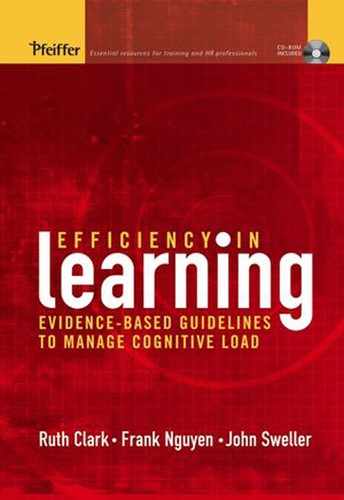IN PART III WE INCLUDE only one chapter on proven techniques you can use to increase germane cognitive load. The reason for reducing extraneous load and managing intrinsic load is to free up working memory capacity for processing that leads to learning. Instructional strategies that lead to learning require mental work, which imposes germane cognitive load.
As research evolves, additional methods may be found that impose germane cognitive load. However, based on evidence currently available, in this part of the book we review four main methods that promote learning and transfer of learning. These include: the use of diverse worked examples to build more flexible mental models that support transfer of learning; encouraging learner explanations of worked examples in order to process them deeply; rehearsals that lead to automation of new knowledge and skills; and mental rehearsal of complex content after initial mental models are formed.
Read | To Find Out How to |
Chapter 9. Put Working Memory to Work with Germane Load | Support transfer of learning with diverse worked examples Promote learner self-explanations of worked examples Help learners automate new skills Promote mental rehearsal after initial formation of mental models |
Video Interview with John Sweller: Chapter Preview/Review
Chapter 9. Put Working Memory to Work with Germane Load. Overview of germane load, use of variable worked examples, self-explanations, and mental rehearsals
Sample Excel e-Lessons
After: Load-Managed Excel Web-Based Lesson. This asynchronous e-learning sample imposes germane cognitive load through varied context worked examples and practice exercises.
Virtual Classroom Example. This synchronous e-learning sample imposes germane cognitive load through varied context completion examples and practice exercises.
Shifting from Extraneous to Relevant (Germane) Load
Guideline 21: Use Diverse Worked Examples to Foster Transfer of Learning
Near vs. Far Transfer of Learning
Getting Beneath the Cover Story
How to Build Flexible Schemas That Support Far Transfer
What Are Varied Context Examples?
The Psychology of Varied Context Worked Examples
Applying the Research
Guideline 22: Help Learners Exploit Examples Through Self-Explanations
What Are Self-Explanations?
What Is a Good Self-Explanation?
Applying the Research
Self Versus Peer Explanations
Guideline 23: Help Learners Automate New Knowledge and Skills
What Is Automaticity
How Do Skills Become Automatic?
When to Build Automatic Skills
Applying the Research
Guideline 24: Promote Mental Rehearsal of Complex Content After Mental Models Are Formed
What Is Mental Rehearsal?
When to Use Mental Rehearsal
Applying the Research
The Bottom Line
On the CD
John Sweller Video Interview
Sample Excel e-Lessons
